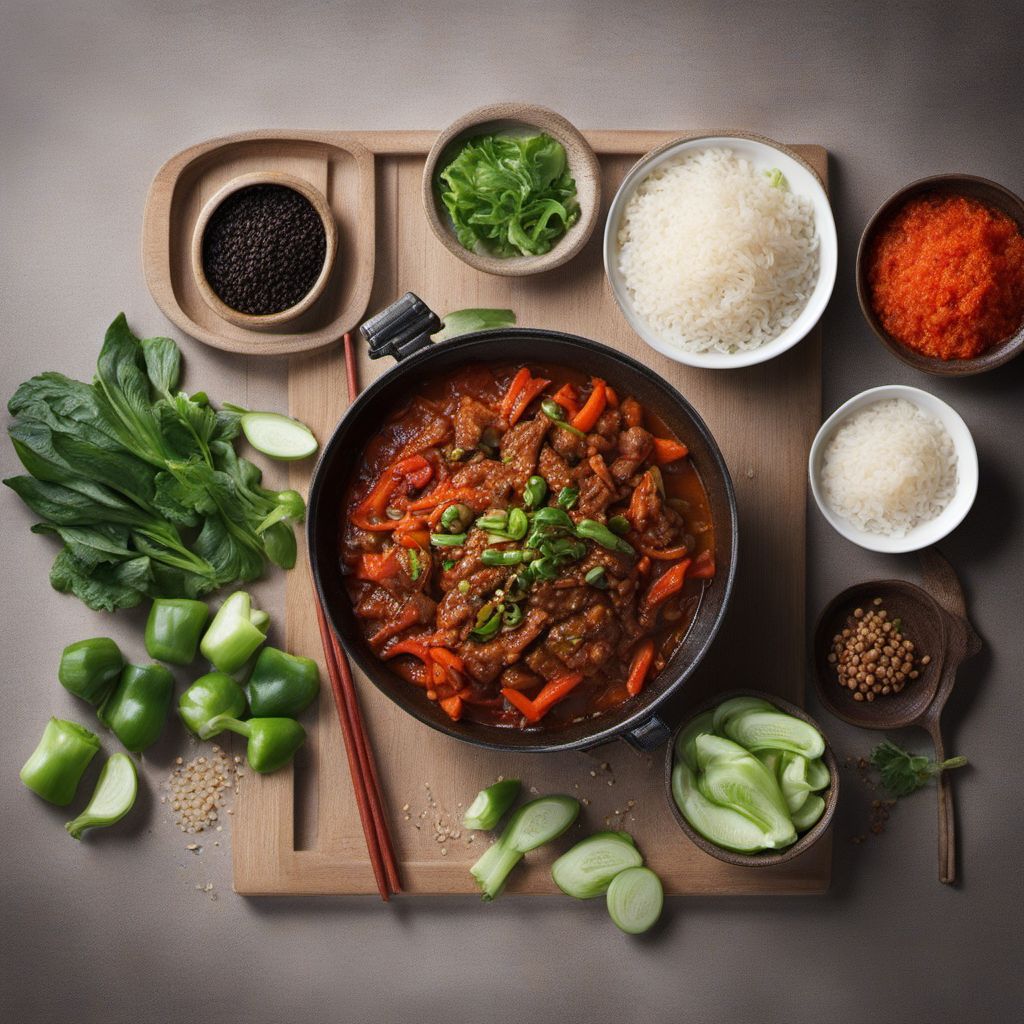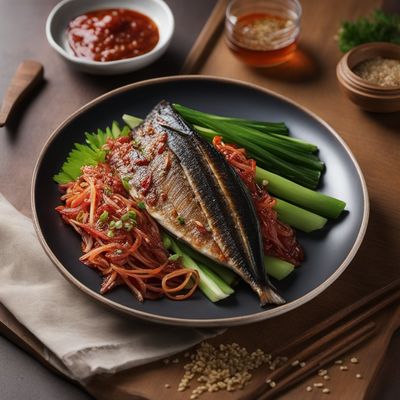
Recipe
Korean Chinese Style Vegetable Kadai
Spicy and Flavorful Korean Chinese Vegetable Stir-Fry
4.7 out of 5
This recipe combines the vibrant flavors of Korean and Chinese cuisines to create a delicious and spicy vegetable stir-fry. Packed with fresh vegetables and aromatic spices, this dish is a perfect balance of heat and umami.
Metadata
Preparation time
15 minutes
Cooking time
10 minutes
Total time
25 minutes
Yields
4 servings
Preparation difficulty
Easy
Suitable for
Vegetarian, Vegan, Gluten-free, Dairy-free, Nut-free
Allergens
Soy
Not suitable for
Paleo, Keto, Low-carb, High-protein, Whole30
Ingredients
In the original Indian Vegetable Kadai, the dish is prepared with a blend of Indian spices such as garam masala, turmeric, and coriander. However, in this Korean Chinese adaptation, we replace these spices with Korean chili paste, soy sauce, ginger, and garlic to infuse the dish with the distinct flavors of Korean and Chinese cuisines. Additionally, we incorporate a variety of vegetables commonly used in Korean Chinese cooking, such as bell peppers, carrots, mushrooms, and cabbage, to enhance the dish's texture and taste. We alse have the original recipe for Vegetable kadai, so you can check it out.
-
2 tablespoons vegetable oil 2 tablespoons vegetable oil
-
1 onion, thinly sliced 1 onion, thinly sliced
-
2 cloves of garlic, minced 2 cloves of garlic, minced
-
1-inch piece of ginger, grated 1-inch piece of ginger, grated
-
1 red bell pepper, thinly sliced 1 red bell pepper, thinly sliced
-
1 green bell pepper, thinly sliced 1 green bell pepper, thinly sliced
-
1 carrot, julienned 1 carrot, julienned
-
1 cup mushrooms, sliced 1 cup mushrooms, sliced
-
1 cup cabbage, shredded 1 cup cabbage, shredded
-
2 tablespoons Korean chili paste (gochujang) 2 tablespoons Korean chili paste (gochujang)
-
2 tablespoons soy sauce 2 tablespoons soy sauce
-
1 tablespoon rice vinegar 1 tablespoon rice vinegar
-
1 tablespoon honey 1 tablespoon honey
-
1 teaspoon sesame oil 1 teaspoon sesame oil
-
Salt, to taste Salt, to taste
-
Freshly ground black pepper, to taste Freshly ground black pepper, to taste
-
Spring onions, for garnish Spring onions, for garnish
Nutrition
- Calories (kcal / KJ): 180 kcal / 753 KJ
- Fat (total, saturated): 8g, 1g
- Carbohydrates (total, sugars): 24g, 12g
- Protein: 4g
- Fiber: 5g
- Salt: 1.5g
Preparation
-
1.Heat vegetable oil in a wok or large skillet over medium-high heat.
-
2.Add the sliced onion and sauté until translucent.
-
3.Stir in the minced garlic and grated ginger, and cook for another minute.
-
4.Add the bell peppers, carrot, mushrooms, and cabbage to the wok. Stir-fry for 3-4 minutes until the vegetables are slightly tender.
-
5.In a small bowl, whisk together the Korean chili paste, soy sauce, rice vinegar, honey, sesame oil, salt, and black pepper.
-
6.Pour the sauce over the vegetables in the wok and toss to coat evenly.
-
7.Continue stir-frying for another 2-3 minutes until the vegetables are cooked but still retain their crunchiness.
-
8.Garnish with spring onions and serve hot with steamed rice or noodles.
Treat your ingredients with care...
- Mushrooms — Make sure to clean the mushrooms properly and slice them thinly for even cooking.
- Korean chili paste (gochujang) — Adjust the amount according to your spice preference. Add more for extra heat or reduce for a milder flavor.
- Rice vinegar — If you don't have rice vinegar, you can substitute it with apple cider vinegar or white vinegar.
- Sesame oil — Use toasted sesame oil for a more pronounced nutty flavor.
Tips & Tricks
- For an extra kick of heat, add some sliced red chili peppers along with the bell peppers.
- Feel free to customize the vegetable selection based on your preference and seasonal availability.
- To make it a heartier meal, you can add tofu, seitan, or tempeh for added protein.
- Serve the Korean Chinese Vegetable Kadai with a side of steamed rice or noodles for a complete meal.
- Leftovers can be stored in an airtight container in the refrigerator for up to 3 days.
Serving advice
Serve the Korean Chinese Vegetable Kadai hot as a main dish with steamed rice or noodles. Garnish with fresh spring onions for added freshness and color.
Presentation advice
Arrange the colorful stir-fried vegetables on a serving platter, and sprinkle some sesame seeds on top for an attractive presentation. Serve with a side of steamed rice or noodles.
More recipes...
More Indian cuisine dishes » Browse all

Boti kebab
Spicy grilled meat skewers
Boti kebab is a popular Indian dish made with marinated lamb that is grilled to perfection. It is a flavorful and spicy dish that is perfect for a...

Laccha paratha
Laccha paratha is a type of Indian bread that is layered and flaky. It is a popular dish in North India and is often served with curries or chutneys.

Aloo baingan
Potatoes and Eggplant Curry
Aloo baingan is a popular vegetarian dish from the Indian subcontinent. It is made with potatoes and eggplant cooked in a spicy tomato-based sauce.









